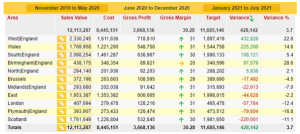For most businesses, the annual sales budgeting process is a real headache – involving hours of time and, more often than not, a lot of intelligent guesswork!
Why is the sales budget process so difficult?
Particularly for SMEs with limited financial and IT resources, producing and monitoring an accurate sales budget is immensely challenging and absorbs a huge amount of staff time and energy.
In reality many managers regard the process as so time consuming and unreliable that they question the whole purpose – see the PWC report on business attitude to the annual budget here.
The good news is that it doesn’t have to be like this.
We think there are 7 practical steps you can take immediately to fix your sales budget headaches for good.
1. Build your sales budget based on manageable chunks to easily measure performance
For most businesses, building the sales budget by forecasting sales for every item on a week by week basis would be an enormous job to compile and to manage.
A better approach is to group by say, product types or geographical areas – whatever makes sense for your business. However you build your sales budget, you must be confident that you can easily monitor actual performance.
For this reason typically businesses will set weekly or monthly targets, with the quarterly numbers acting as good rallying points as the year progresses.
In order to arrive at a reliable sales budget you will need input from across the business and in particular, the sales team.
Here are some questions you might like to think about
If you have sales reps, area managers or product managers, what special knowledge do they each have on the customers and sales they are responsible for?
Looking at each category of sales, what is the most effective way to monitor performance? Is it by industry sector; location; value- there are likely to be multiple options.
Carefully consider how much value there is in managing very detailed budgets.
For example, it might make sense to set individual budgets for ,say, your top 25 customers with a single budget for “everyone else”
IMPORTANTLY, can you easily get to the actual sales that match each of these items. For example, it’s no use budgeting per delivery postcode area if your sales reporting data does not include that information. Sounds obvious but we often see such mismatches.
2. Build your best sales budget by making use of historic data
For mature businesses, the starting point for every sales budget is “how are we doing against this year’s sales budget and how did we do last year”.
The finance systems hold all of this information. The problem is accessing it in a timely manner and at a sufficient level of granularity to be really useful.
Pulling up a report on e.g., sales to the top 10 customers should be straightforward but breaking total sales into individual orders to identify true sales patterns is a much bigger task.
Using spreadsheets to gather all of this data together manually typically means relying on over-stretched finance teams, leading to more delay and ultimately a sales budget that may not be completely robust.
By contrast, easy to use business reporting software will automate this task for you, allowing every manager to build their own elements of the sales budget directly from accurate, granular data.
The end result is a sales budget based on a full and detailed understanding of previous years performance which managers own for themselves.
Our Octelas business reporting software is your one-stop-shop for analysing all your historic data.
3. Know how much gross profit you make on every sale
Self evidently, in setting a sales budget for the year you have in mind the amount of profit you are aiming to achieve in that year.
That being the case, setting a sales budget which only tracks gross sales value and/or quantities sold leaves you at risk of undershooting your profit target.
Incentivising staff to drive sales usually leads to excessive discounting.
In the worst case, you could be working the business hard to achieve your headline turnover only to find that (after discounting and/or staff commissions) gross profit is significantly less than you had budgeted for.
Given that in most businesses overhead costs are largely fixed, this means that managers must have a good handle on the gross profit needed from sales of each product type.
Whilst the data needed to calculate gross profit on a per product basis is usually buried somewhere in the accounts system, getting to it and then making the calculation is extremely difficult and time consuming.
So many businesses never do it and rely instead on “gut feel”.
For those businesses that always sell against a fixed price list, probably this lack of data is not important. Total sales less total net “Cost of Goods Sold” (also known as COGS) is good enough to establish gross profit per sale.
However most businesses are not that fortunate.
You may sell bundles of goods at special prices or you may need to deal with over-stocks and/or offer special discounts to regular customers or for large quantities.
You may buy and/or sell overseas so moving exchange rates might significantly affect profit margins.
The variations are endless.
If any of this applies to your business, it is essential that you can quickly and easily establish the true gross profit on every category of sale.
It is equally important to compare current and past years performance at this granular level in order to establish trends.
As the following diagrams clearly illustrate, reliance solely on sales turnover as a measure of success can mask significant underlying problems which need to be addressed.
In Figure 1, we are looking at the total sales ytd in our fictional company, measured against the sales budget for the year. Everything looks to be going great.
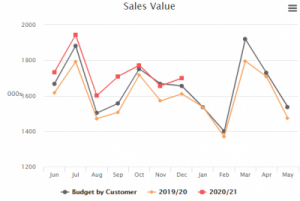
In Figure 2 however we see the gross profit for the same sales against the set budget for the year and suddenly we can see that profitability on sales is well down…
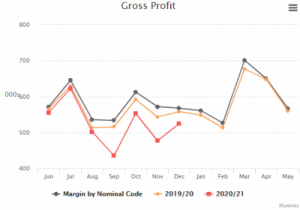
With access to easy to use business reporting software, managers can see these trends building on a day by day basis, giving them the ability to take action immediately to investigate and resolve the problem areas.
Our Octelas business reporting software can report gross margin in one click.
4. The best sales budgets allow for seasonality
In many businesses, sales are affected by seasonal buying patterns.
If this applies to your business, then you will know that it is critically important that you take this into account when building your sales budget.
This seasonality may affect the majority of your sales, for example in a typical December you might achieve 12% of your annual sales whereas in August it’s more like 5%.
The chart below shows an average of sales taken over 3 years for a real business with a highly seasonal sales profile.
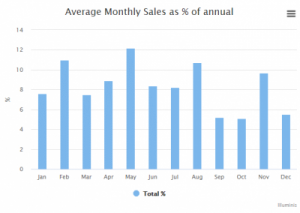
Alternatively there may be significant differences between certain product types or ranges – if we break the sales for the real business above into the individual brands sold, there are significant differences across the year.
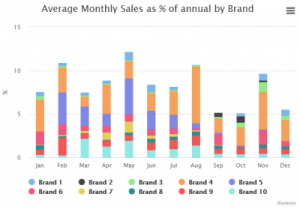
For many businesses, access to completely accurate, detailed historic data on sales, which can be interrogated at different levels, is virtually impossible. Therefore they are unable to get a full picture on customer buying patterns.
To keep track of this level of detailed data, you need simple, easy to use. business reporting software to do the heavy lifting for you.
With business reporting software at your fingertips, adjusting the sales budget for seasonality is completely hassle free.
Likewise you have the ability at your fingertips to effortlessly monitor progress of seasonal sales against sales budget day by day.
Our Octelas business reporting software is your one-stop-shop for spotting seasonal trends.
5. Monitor actual performance against budget – at least monthly
There is no point in building a detailed sales budget only to put it away in the drawer to be forgotten about until next year.
Everyone knows this. Monitoring performance of actual sales against budget needs to be a routine task.
Relying on spreadsheets to keep track of this process is difficult and time consuming. Often it becomes at best a monthly activity.
Simple, easy to use business reporting software takes on this task for you.
The algorithms built into the software can match up actual performance to the sales budget so you can get a “one click” update on how each part of the business is faring.
Having all your data in one place, and automatically updated every day, allows managers to interrogate the whole data set quickly and easily. Underperformance is highlighted immediately. Likewise the reasons for underperformance can be identified.
By taking steps to reset and re-energise team efforts in real time and as the problem is unfolding, you are giving the business the best possible chance to get back on track before minor issues turn into major problems.
As the following table clearly illustrates, reliance solely on total sales (or gross profit or other single metric) as a measure of success can mask significant underlying problems which need to be addressed.
In Figure 1 above looking at the total sales ytd everything looks to be going great.
However, look behind the top level numbers and we see a different picture. The table below from our Octelas business reporting software shows the same sales ytd but this time broken down into sales areas and suddenly we can see that whilst some areas are exceeding budget, others are well below budget.
